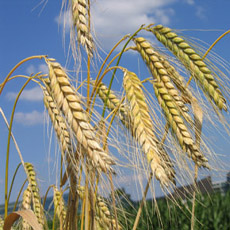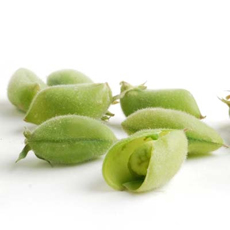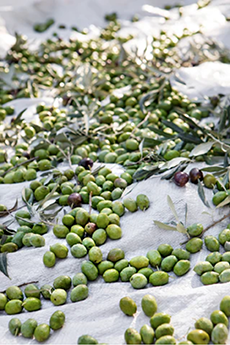FOOD 101: The First Cultivated Crops, The History Of Agriculture
 [1] Emmer wheat, one of the eight founder crops (photo © Sortengarten).
|
All of the plant-based food we eat first grew wild. When man transitioned from packs of nomadic hunter-gatherers to settled villages of farmers, they learned to cultivate the foods that were most important to them. This happened some 10,000 or 11,000 years ago, in the Neolithic Age (sometimes referred to as the Agricultural Revolution). Man domesticated animals as well; and the stable food supply supported an increasingly large population. The Neolithic Age is considered to be the final stage of cultural evolution among prehistoric humans: living together in communities. Also called the New Stone Age, it was the period where man developed stone tools by polishing or grinding*, and began to develop crafts such as pottery and weaving. After 9500 B.C.E. the eight so-called “founder crops” of agriculture appear in the Fertile Crescent, the land in and around the Tigris and Euphrates rivers. That area is now include Mesopotamia, and the Levant*, the eastern coast of the Mediterranean Sea. The eight wild crops that were the first to be cultivated were: |
|
|
____________________________ *The previous age or period, the Paleolithic, was the age of chipped-stone tools. Following the Neolithic was the Bronze Age, which saw the development of metal tools. †The Levant was a large area in southwest Asia: south of the Taurus Mountains, with the Mediterranean Sea as the western boundary, and the north Arabian Desert and Mesopotamia in the east. “Levant” is an English term that first appeared in 1497. It originally referred to the “Mediterranean lands east of Italy.” The historical area comprises modern-day Iraq, Israel, Jordan, Lebanon, Palestine and Syria. Among other popular foods, Levantine cuisine gave birth to baklava, balafel, kebabs, mezze (including tabbouleh, hummus and baba ghanoush), pita and za’atar, among other dishes that are enjoyed in the U.S. and around the world. Scientists have found remains of figs in Jericho, near the Jordan River in what is now called the West Bank, an area formerly called Palestinian territories and the State of Palestine. They appear to be the earliest known cultivated fruit crop—and perhaps the first cultivated crop anywhere. The figs were dated to 11,400 years ago. As archaeologists continue to unearth new evidence, our knowledge will evolve. For example, the latest findings show that the olive was first domesticated in the eastern Mediterranean between 8,000 and 6,000 years ago, following figs as the earliest domesticated fruit. Even with the advent of farming, other foods were still gathered wild, including lentils, almonds and pistachios, wild oats and wild barley. No food source was left uneaten! Remains of dates have been found on a number of Neolithic sites, particularly in Syria and Egypt. This means that they were being eaten by man as much as 7,000 to 8,000 years ago, although we have no proof that they were cultivated that early. [Source] Sheep and goats were the first domesticated food animals, followed by cattle and pigs. Man’s best friend, the dog, was domesticated in the Paleolithic by hunter-gatherers, some 12,000 years ago. |
||
|
HOW DID FARMING BEGIN? People collected and planted the seeds of wild plants. Over time, the first farmers learned how much water and sunlight were needed for success. Weeks or months later, when the plants blossomed, they harvested the food crops. > National Agriculture Week (Ag Week) is the 3rd week in March. > National Agriculture Day (Ag Day) is the third Tuesday in March. |
|
|
|
CHECK OUT WHAT’S HAPPENING ON OUR HOME PAGE, THENIBBLE.COM. |
||





